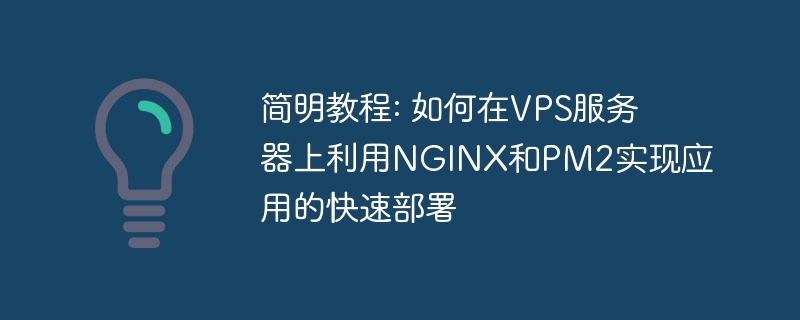Home > Article > Operation and Maintenance > Concise tutorial: How to use NGINX and PM2 to quickly deploy applications on a VPS server

Concise Tutorial: How to use NGINX and PM2 to implement rapid application deployment on VPS servers
With the development of the Internet, more and more applications are deployed on On a Virtual Private Server (VPS). Rapidly deploying applications on VPS is an important and necessary skill for developers and operation and maintenance personnel.
This tutorial will guide you on how to use NGINX and PM2, two commonly used tools, to quickly deploy your application on a VPS server. First, we need to understand the basic concepts and usage of NGINX and PM2.
1. NGINX
NGINX is a high-performance web server and reverse proxy server. It can handle high-concurrency requests and serve static and dynamic content. In this tutorial, we will use NGINX as the entry point for our application and also configure it as a reverse proxy server.
The installation method of NGINX may vary depending on the server operating system. You can choose the appropriate installation method according to your server environment. After the installation is complete, we need to perform some basic configuration on NGINX.
First, we need to create an NGINX configuration file (for example: myapp.conf). In this configuration file, you need to specify the listening port number and domain name, as well as the address and port number of the application to which the reverse proxy is directed. The following is the content of a sample configuration file:
server {
listen 80;
server_name mydomain.com;
location / {
proxy_pass http://127.0.0.1:3000;
proxy_set_header Host $host;
}
} Please note that in this example, we set the application address and port number to http://127.0.0.1:3000, in fact You need to replace it with the actual address and port number of your application.
After the configuration file is ready, save it in the NGINX configuration file directory (for example: /etc/nginx/conf.d/). Then, restart the NGINX service to make the configuration file take effect.
2. PM2
PM2 is a process management tool that can help you simplify the deployment and management of applications in a production environment. In this tutorial, we will use PM2 to launch our application and ensure that it continues to run in the background.
First, we need to install PM2 globally. You can install it by running the following command:
npm install -g pm2
After the installation is complete, we can use PM2 to start our application. Assuming your application is a Node.js server, you can use the following command to start it:
pm2 start app.js
If your application is an Express application, you can use the following command to start it:
pm2 start bin/www
PM2 also provides some other useful commands, such as listing all running applications, restarting applications, stopping applications, etc. You can get more help about PM2 commands by running the pm2 --help command.
3. Deploy applications
Now, you have installed NGINX and PM2 and completed their basic configuration. Next, let's deploy our application.
First, make sure your application has been uploaded to your VPS server. Then, create a new folder on your server to store your application.
Then, go into this folder and use the git clone command to clone the code from your code repository. Alternatively, you can copy your code files directly into this folder.
Next, install the dependencies required by the application. You can use the npm install command to install all dependencies.
Then, use PM2 to start your application. In your application directory, run pm2 start app.js or pm2 start bin/www, and choose the appropriate startup command according to your actual situation.
Finally, access your app using your domain name and if all goes well, you should be able to see your app running successfully in the browser.
4. Manually update the application
If your application needs to be updated manually while it is running, just use the git pull command in your application directory to pull it. Latest code. Then, use the pm2 restart app command to restart the application.
If your application does not use Git as the version control system, you can manually copy the new code files to the application directory, and then run the corresponding pm2 restart command to restart the application.
Summary
By simply configuring NGINX and using PM2 to deploy and manage applications, you can quickly deploy your application to a VPS server and run it stably in a production environment.
During the actual deployment process, we may also need to consider other issues, such as security, performance optimization, load balancing, etc. But in this tutorial, we only focus on the most basic deployment methods.
I hope this tutorial will help you deploy applications on your VPS server. If you have any questions about using NGINX and PM2, we recommend reading the official documentation for more detailed information. Good luck with your deployment on VPS!
The above is the detailed content of Concise tutorial: How to use NGINX and PM2 to quickly deploy applications on a VPS server. For more information, please follow other related articles on the PHP Chinese website!